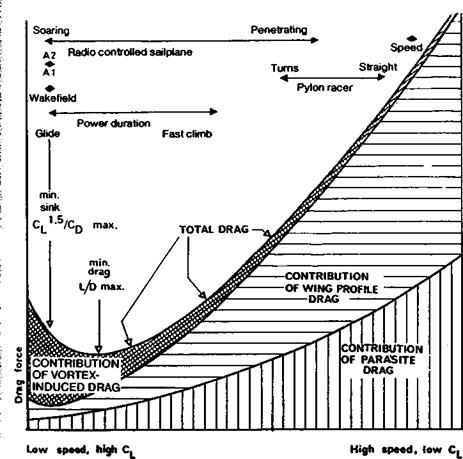THE DRAG BUDGET
4t
In Figure 4.10 an attempt has been made to summarise in one. diagram the relative importance to different types of model of the various main types of drag. At high speeds and low lift coefficients, parasite and profile drag are dominant, vortex-induced drag is small. It follows for all models such as racers, gliders when penetrating and high powered! duration models in the climb, that design efforts should be concentrated on reducing profile and parasite drag. For slow flying models, such as soaring gliders and gliding
l

I Fig. 4.10 The drag budget
duration types, induced drag is dominant, profile drag comes a very poor second (unless by very bad choice of aerofoil, laminar separation occurs), and parasite drag is relatively unimportant. The diagram has general value, and is in many respects the key to the rest of this book. Obviously, if a racing model has been refined as far as possible with respect to profile and parasite drag, a very little further improvement will result if some attention is finally given to vortex drag reduction. Similarly, if a ‘duration’ model on the glide has vortex and profile drags cut to the minimum possible, a general ‘clean up’ of parasite drag items will bring further, but minor, improvement. The diagram gives indications as to where the main emphasis must lie. (The methods used in calculating such a drag budget for a particular model are outlined in Appendix 1.)
|
*•—– " / / u. / alt*. і • L – I |
|
/ **—– —- / / ‘olV I I L _ I |
 |
In all cases it should be noted that the wing alone is the main source of drag, either because of the vortex-induced drag at low speeds or because of aerofoil profile drag at high velocities. Parasitic drag — of tail or forewing, fuselage, interference between the various components, gaps and small protrusions — becomes important for all fast flying models but the wing is still dominant.
Fig. 4.11
A balloon moves with the air in which it flies. The people on board feel no breeze. A model aeroplane flying perfect circles in the air with the balloon basket as the centre, will maintain a steady airspeed and constant bank angle. From below, observers on the ground see the aircraft changing its apparent speed and become confused. To fly a model correctly the pilot should imagine only the airflow passing over the model.











